| Article ID | Journal | Published Year | Pages | File Type |
|---|---|---|---|---|
| 10956594 | Molecular and Cellular Neuroscience | 2011 | 12 Pages |
Abstract
Embryonic stem cells (ESC) and the epiblast share a similar gene expression profile and an attenuated cell cycle, making them an accessible and tractable model system to study lineage choice at gastrulation. Differentiation of the epiblast and ESC to the mesendodermal lineage has been shown to rely on Wnt/β-catenin signaling; which counterintuitively, is also required to inhibit differentiation and maintain pluripotency. To examine these seemingly contradictory roles, we developed a mouse ESC (ESC) line that inducibly expresses a dominant negative Tcf4 (dnTcf4) protein to block canonical Wnt signaling. Cells expressing the dnTcf4 protein differentiated largely to Sox3 positive neural precursors but were unable to progress to βIII tubulin positive neurons unless Wnt signaling was derepressed, demonstrating a sequential requirement for Wnt signaling in lineage differentiation. To determine if Wnt/β-catenin signaling is similarily required at sequential stages of neural differentiation in the intact embryo, we delivered shRNA targeting β-catenin to pregnant mice on E5.5 of development. Blocking canonical Wnt signaling during post-implantation development increased the number of neural precursors which failed to differentiate to mature neurons, and produced defects of embryonic axis elongation, neurulation and neural tube closure that phenocopy the β-catenin null embryo. These results demonstrate that lineage differentiation relies on sequential repression and derepression of critical signaling pathways involved in maintaining pluripotency versus differentiation.
Related Topics
Life Sciences
Biochemistry, Genetics and Molecular Biology
Cell Biology
Authors
N.A. Slawny, K.S. O'Shea,
